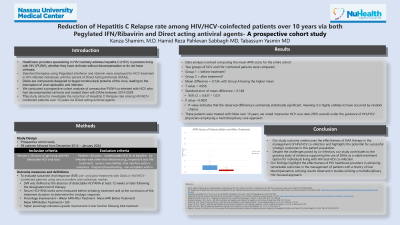Monday Poster Session
Category: Liver
P2956 - Reduction of Hepatitis C Relapse Rate Among HIV/HCV - Coinfected Patients Over 10 Years via Direct Acting Antiviral Agents: A Retrospective Cohort Study
Monday, October 28, 2024
10:30 AM - 4:00 PM ET
Location: Exhibit Hall E

Has Audio

Kanza Shamim, MD
Nassau University Medical Center
Merrick, NY
Presenting Author(s)
Kanza Shamim, MD1, Hamid Reza Pahlevan Sabbagh, MD2, Tabassum Yasmin, MD2
1Nassau University Medical Center, Merrick, NY; 2Nassau University Medical Center, East Meadow, NY
Introduction: The medical community increasingly acknowledges the substantial impact of HIV/hepatitis C virus (HCV) coinfection. With the advent of Direct-Acting Antivirals (DAAs) in last decade, response rates to HCV therapy in coinfected patients have significantly improved. Optimal management with DAAs has resulted in lower rates of liver fibrosis and reduced risk of liver-related complications among HIV/HCV-coinfected patients, bringing outcomes more in line with those seen in HCV-monoinfected patients.
Methods: In this retrospective cohort, HIV/HCV-coinfected patients were studied between December 2014 to January 2024. Sustained virologic response (SVR) pre- and post-treatment and the degree of fibrosis was determined using non-invasive modality such as HCV RNA levels and aspartate aminotransferase (AST)-to-platelet ratio index (APRI) index scoring. The Data Analysis was done via calculating mean APRI score for the entire cohort before and after DAA treatment. The percentage improvement in the sum of APRI scores was determined by comparing the mean APRI between group one (before treatment) to the mean APRI of group two (after treatment).
Results: The analysis found a mean difference of APRI index of 0.734 between Group One and Group Two. The calculated standard error of the mean difference (SE_diff) is approximately 0.148. The t-value for the difference was computed to be approximately 4.956 with P-value of less than 0.0001. The 95% confidence interval for the mean difference was calculated to be (0.437, 1.031) that was statistically significant indicating impressive HCV cure rates with DAA in 10 yrs.
Discussion: HIV accelerates the development of liver disease associated with HCV. The progression occur in less than half that time in those who are co-infected ¹. Our ability to develop successful treatments for HCV necessitates finding approaches to effectively treat individuals living with HIV who have traditionally posed treatment challenges. The main objective of treating HCV is to attain a sustained virologic response, leading to regression of fibrosis, resolution of extrahepatic manifestations, and a decrease in the risk of transmission ². Additionally, for patients without a sustained virologic response, the advancement of fibrosis could be mitigated through suppressive maintenance therapy ³. Identification of HIV-infected individuals with concurrent HCV positivity should involve HCV antibody screening, and treatment consideration is recommended.
Disclosures:
Kanza Shamim, MD1, Hamid Reza Pahlevan Sabbagh, MD2, Tabassum Yasmin, MD2. P2956 - Reduction of Hepatitis C Relapse Rate Among HIV/HCV - Coinfected Patients Over 10 Years via Direct Acting Antiviral Agents: A Retrospective Cohort Study, ACG 2024 Annual Scientific Meeting Abstracts. Philadelphia, PA: American College of Gastroenterology.
1Nassau University Medical Center, Merrick, NY; 2Nassau University Medical Center, East Meadow, NY
Introduction: The medical community increasingly acknowledges the substantial impact of HIV/hepatitis C virus (HCV) coinfection. With the advent of Direct-Acting Antivirals (DAAs) in last decade, response rates to HCV therapy in coinfected patients have significantly improved. Optimal management with DAAs has resulted in lower rates of liver fibrosis and reduced risk of liver-related complications among HIV/HCV-coinfected patients, bringing outcomes more in line with those seen in HCV-monoinfected patients.
Methods: In this retrospective cohort, HIV/HCV-coinfected patients were studied between December 2014 to January 2024. Sustained virologic response (SVR) pre- and post-treatment and the degree of fibrosis was determined using non-invasive modality such as HCV RNA levels and aspartate aminotransferase (AST)-to-platelet ratio index (APRI) index scoring. The Data Analysis was done via calculating mean APRI score for the entire cohort before and after DAA treatment. The percentage improvement in the sum of APRI scores was determined by comparing the mean APRI between group one (before treatment) to the mean APRI of group two (after treatment).
Results: The analysis found a mean difference of APRI index of 0.734 between Group One and Group Two. The calculated standard error of the mean difference (SE_diff) is approximately 0.148. The t-value for the difference was computed to be approximately 4.956 with P-value of less than 0.0001. The 95% confidence interval for the mean difference was calculated to be (0.437, 1.031) that was statistically significant indicating impressive HCV cure rates with DAA in 10 yrs.
Discussion: HIV accelerates the development of liver disease associated with HCV. The progression occur in less than half that time in those who are co-infected ¹. Our ability to develop successful treatments for HCV necessitates finding approaches to effectively treat individuals living with HIV who have traditionally posed treatment challenges. The main objective of treating HCV is to attain a sustained virologic response, leading to regression of fibrosis, resolution of extrahepatic manifestations, and a decrease in the risk of transmission ². Additionally, for patients without a sustained virologic response, the advancement of fibrosis could be mitigated through suppressive maintenance therapy ³. Identification of HIV-infected individuals with concurrent HCV positivity should involve HCV antibody screening, and treatment consideration is recommended.
Disclosures:
Kanza Shamim indicated no relevant financial relationships.
Hamid Reza Pahlevan Sabbagh indicated no relevant financial relationships.
Tabassum Yasmin indicated no relevant financial relationships.
Kanza Shamim, MD1, Hamid Reza Pahlevan Sabbagh, MD2, Tabassum Yasmin, MD2. P2956 - Reduction of Hepatitis C Relapse Rate Among HIV/HCV - Coinfected Patients Over 10 Years via Direct Acting Antiviral Agents: A Retrospective Cohort Study, ACG 2024 Annual Scientific Meeting Abstracts. Philadelphia, PA: American College of Gastroenterology.
